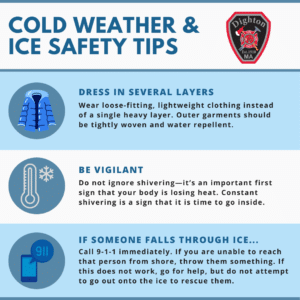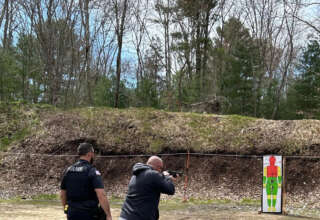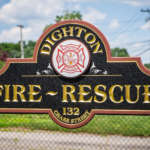
Chief Christopher Maguy and the Dighton Fire Department would like to provide cold weather and ice safety tips to residents during the winter months.
According to the Centers for Disease Control and Prevention (CDC), cold weather induced illnesses such as frostbite can occur even in temperatures above 40°F if a person becomes chilled by rain or sweat, or is submerged in cold water.
On Tuesday, Jan. 11, an arctic blast is set to move through the northeast region of the U.S. with temperatures predicted to be in the single or teen digits and wind chills below zero all day.
The Dighton Fire Department wishes to share the following tips from the CDC to help keep residents safe in cold weather situations and conditions.
- When going outdoors, adults and children should wear:
- A hat
- Scarf or knit mask to cover face and mouth
- Long sleeves that are snug at the wrist
- Mittens (they are warmer than gloves)
- Water-resistant coat and boots
- Residents are also reminded to layer their clothing strategically:
- When choosing an inner layer, wear fabrics that will hold more body heat and do not absorb moisture. Wool, silk, or polypropylene will hold more body heat than cotton.
- Wear a layer of clothing for insulation. An insulation layer will help you retain heat by trapping air close to your body. Natural fibers, like wool, goose down, or a fleece work best.
- Select your outer layer carefully. The outermost layer helps protect you from wind, rain, and snow. It should be tightly woven, and preferably water and wind resistant, to reduce loss of body heat.
- Try to stay dry while outdoors, as wet clothing chills the body quickly.
- Excess sweating will cause your body to lose more heat, so remove extra layers of clothing whenever you feel too warm.
- Avoid getting gasoline or alcohol on your skin while de-icing and fueling your car or using a snow blower. Getting these on your skin will cause your body to lose a lot more heat.
- Do not ignore shivering, as it’s an important first sign that your body is losing heat. Constant shivering is a sign that it is time to go inside.
For additional information from the CDC regarding cold weather safety, click here.
Pet owners are also reminded to take precautions during cold weather. According to the American Veterinary Medical Association (AVMA), cold tolerance varies from pet to pet, and owners should be aware of their pet’s tolerance and adjust their activities accordingly. No pet should be left outside for long periods of time during below-freezing weather. Owners should check their dog’s paws frequently for signs of cold-weather injury, such as cracked paw pads or bleeding. Following a walk, owners should also wipe down their pet’s feet, legs and belly to remove chemicals such as deicers or antifreeze.
It is also recommended that you check underneath your car, bang on the hood and honk the horn as a warm vehicle engine can be an appealing heat source for outdoor or feral cats. For more tips regarding cold weather and animals, visit the AVMA.
General Ice and Cold Water Safety
The Executive Office of Energy and Environmental Affairs recommends measuring ice in multiple places before testing it with your weight. Ice that is two inches thick or less should be avoided completely. Four inches or more is considered safe for ice fishing or any other activity on foot. Five inches of ice is recommended for snowmobiles or ATVs. Eight to 12 inches is needed for a small car, while a foot to 15 inches is recommended for trucks.
The Dighton Fire Department shares the following tips for remaining safe on the ice:
- Never go onto the ice alone. A friend may be able to rescue you from shore or go for help if you fall through the ice.
- Go out onto the ice prepared. Make sure to have a cell phone with you in case of emergency, as well as rope or ice picks to help you or someone you’re with should someone fall in.
- Always keep your pets on a leash. If a pet falls through the ice do not attempt a rescue. Call 911 instead.
- New ice is usually stronger than old ice. As the ice ages, the bond between the crystals decays, making it weaker, even if melting has not occurred.
- Beware of ice covered with snow. Snow can insulate ice and keep it strong, but can also insulate it to keep it from freezing.
- Slush indicates that ice is no longer freezing from the bottom and can be weak or deteriorating.
- Ice formed over flowing water (rivers or lakes containing a large number of springs) is generally more dangerous and should be avoided.
- Ice seldom freezes or thaws at a uniform rate. It can be one foot thick in one spot and be only one inch thick 10 feet away.
What To Do If Someone Falls Through Ice:
- Reach-Throw-Go: If someone falls through the ice, call 911. If you are unable to reach that person from shore, throw them something (rope, jumper cables, tree branch, etc.). If this does not work, go for help, but do not attempt to go out onto the ice to rescue them.
- Get medical assistance for the victim immediately.
- If you fall in, try not to panic. Turn toward the direction you came from. Place your hands and arms on the unbroken surface, working forward by kicking your feet. Once out, remain lying on the ice (do not stand) and roll away from the hole. Crawl back to your tracks, keeping your weight distributed until you return to solid ice. Once safe, find shelter and change out of your wet clothes. Seek medical assistance immediately.
###


















